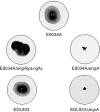Longus, a type IV pilus of enterotoxigenic Escherichia coli, is involved in adherence to intestinal epithelial cells
- PMID: 20348256
- PMCID: PMC2876479
- DOI: 10.1128/JB.01595-09
Longus, a type IV pilus of enterotoxigenic Escherichia coli, is involved in adherence to intestinal epithelial cells
Abstract
Enterotoxigenic Escherichia coli (ETEC) is the leading bacterial cause of diarrhea in the developing world, as well as the most common cause of traveler's diarrhea. The main hallmarks of this type of bacteria are the expression of one or more enterotoxins and fimbriae used for attachment to host intestinal cells. Longus is a pilus produced by ETEC. These bacteria grown in pleuropneumonia-like organism (PPLO) broth at 37 degrees C and in 5% CO(2) produced longus, showing that the assembly and expression of the pili depend on growth conditions and composition of the medium. To explore the role of longus in the adherence to epithelial cells, quantitative and qualitative analyses were done, and similar levels of adherence were observed, with values of 111.44 x 10(4) CFU/ml in HT-29, 101.33 x 10(4) CFU/ml in Caco-2, and 107.11 x 10(4) CFU/ml in T84 cells. In addition, the E9034A Delta lngA strain showed a significant reduction in longus adherence of 32% in HT-29, 22.28% in Caco-2, and 21.68% in T84 cells compared to the wild-type strain. In experiments performed with nonintestinal cells (HeLa and HEp-2 cells), significant differences were not observed in adherence between E9034A and derivative strains. Interestingly, the E9034A and E9034A Delta lngA(pLngA) strains were 30 to 35% more adherent in intestinal cells than in nonintestinal cells. Twitching motility experiments were performed, showing that ETEC strains E9034A and E9034A Delta lngA(pLngA) had the capacity to form spreading zones while ETEC E9034A Delta lngA does not. In addition, our data suggest that longus from ETEC participates in the colonization of human colonic cells.
Figures








Similar articles
-
Effects of lng Mutations on LngA Expression, Processing, and CS21 Assembly in Enterotoxigenic Escherichia coli E9034A.Front Microbiol. 2016 Aug 3;7:1201. doi: 10.3389/fmicb.2016.01201. eCollection 2016. Front Microbiol. 2016. PMID: 27536289 Free PMC article.
-
The Longus type IV pilus of enterotoxigenic Escherichia coli (ETEC) mediates bacterial self-aggregation and protection from antimicrobial agents.Microb Pathog. 2010 Jun;48(6):230-8. doi: 10.1016/j.micpath.2010.03.006. Epub 2010 Mar 19. Microb Pathog. 2010. PMID: 20227481 Free PMC article.
-
Murine immunization with CS21 pili or LngA major subunit of enterotoxigenic Escherichia coli (ETEC) elicits systemic and mucosal immune responses and inhibits ETEC gut colonization.Vet Microbiol. 2017 Apr;202:90-100. doi: 10.1016/j.vetmic.2016.02.001. Epub 2016 Feb 6. Vet Microbiol. 2017. PMID: 26878971 Free PMC article.
-
Colonization factors of enterotoxigenic Escherichia coli.Adv Appl Microbiol. 2015;90:155-97. doi: 10.1016/bs.aambs.2014.09.003. Epub 2014 Nov 12. Adv Appl Microbiol. 2015. PMID: 25596032 Review.
-
Strategies to overexpress enterotoxigenic Escherichia coli (ETEC) colonization factors for the construction of oral whole-cell inactivated ETEC vaccine candidates.Appl Microbiol Biotechnol. 2012 Mar;93(6):2291-300. doi: 10.1007/s00253-012-3930-6. Epub 2012 Feb 16. Appl Microbiol Biotechnol. 2012. PMID: 22350259 Review.
Cited by
-
The role of the minor colonization factor CS14 in adherence to intestinal cell models by geographically diverse ETEC isolates.mSphere. 2023 Oct 24;8(5):e0030223. doi: 10.1128/msphere.00302-23. Epub 2023 Oct 3. mSphere. 2023. PMID: 37787523 Free PMC article.
-
Effects of lng Mutations on LngA Expression, Processing, and CS21 Assembly in Enterotoxigenic Escherichia coli E9034A.Front Microbiol. 2016 Aug 3;7:1201. doi: 10.3389/fmicb.2016.01201. eCollection 2016. Front Microbiol. 2016. PMID: 27536289 Free PMC article.
-
Distribution of classical and nonclassical virulence genes in enterotoxigenic Escherichia coli isolates from Chilean children and tRNA gene screening for putative insertion sites for genomic islands.J Clin Microbiol. 2011 Sep;49(9):3198-203. doi: 10.1128/JCM.02473-10. Epub 2011 Jul 20. J Clin Microbiol. 2011. PMID: 21775541 Free PMC article.
-
Type IV pilin regulation: a transcriptional overview.Crit Rev Microbiol. 2025 Jun 20:1-28. doi: 10.1080/1040841X.2025.2520778. Online ahead of print. Crit Rev Microbiol. 2025. PMID: 40539451 Review.
-
Recombinant Escherichia coli BL21 with LngA Variants from ETEC E9034A Promotes Adherence to HT-29 Cells.Pathogens. 2023 Feb 16;12(2):337. doi: 10.3390/pathogens12020337. Pathogens. 2023. PMID: 36839609 Free PMC article.
References
-
- Acheson, D. W. 1992. Enterotoxins in acute infective diarrhoea. J. Infect. 24:225-245. - PubMed
-
- Alexander, T. J. L. 1994. Neonatal diarrhoea in pigs, p. 151-170. In C. L. Gyles ed., Escherichia coli in domestic animals and humans. CAB International, Wallingford, United Kingdom.
-
- Beachey, E. H. 1981. Bacterial adherence: adhesin-receptor interactions mediating the attachment of bacteria to mucosal surface. J. Infect. Dis. 143:325-345. - PubMed
-
- Bieber, D., S. W. Ramer, C. Y. Wu, W. J. Murray, T. Tobe, R. Fernandez, and G. K. Schoolnik. 1998. Type IV pili, transient bacterial aggregates, and virulence of enteropathogenic Escherichia coli. Science 280:2114-2118. - PubMed
Publication types
MeSH terms
Substances
LinkOut - more resources
Full Text Sources

